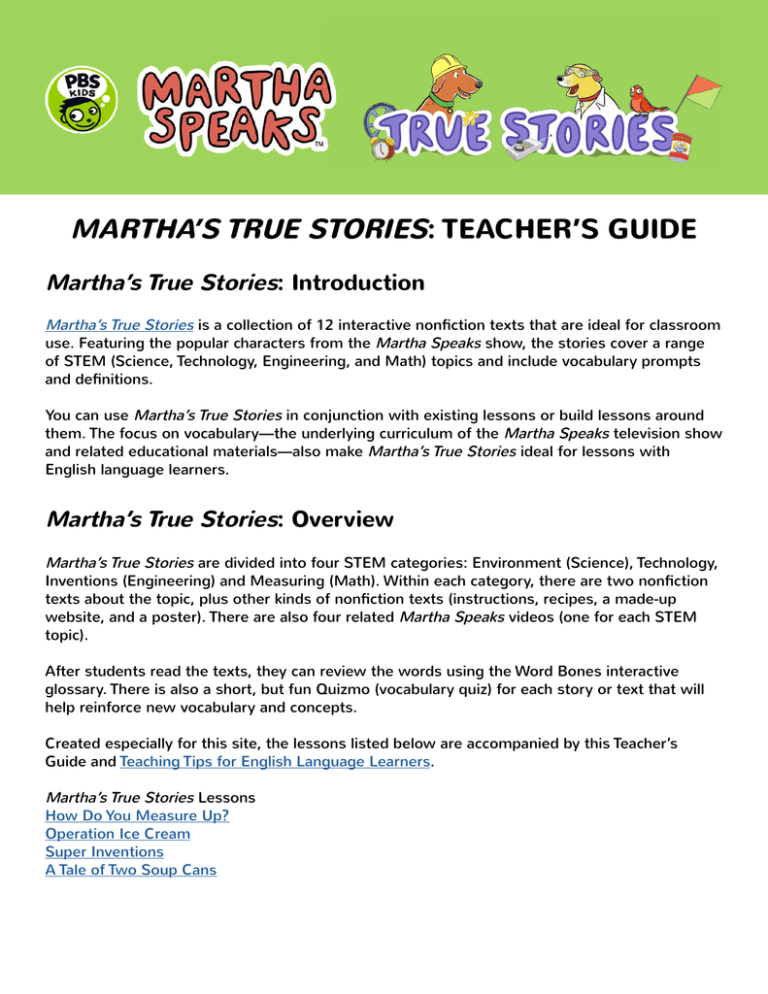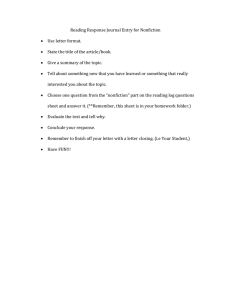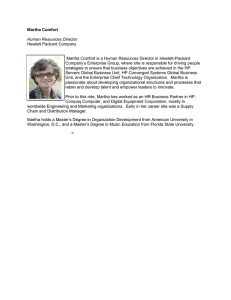
MARTHA’S TRUE STORIES: TEACHER’S GUIDE
Martha’s True Stories: Introduction
Martha’s True Stories is a collection of 12 interactive nonfiction texts that are ideal for classroom
use. Featuring the popular characters from the Martha Speaks show, the stories cover a range
of STEM (Science, Technology, Engineering, and Math) topics and include vocabulary prompts
and definitions.
You can use Martha’s True Stories in conjunction with existing lessons or build lessons around
them. The focus on vocabulary—the underlying curriculum of the Martha Speaks television show
and related educational materials—also make Martha’s True Stories ideal for lessons with
English language learners.
Martha’s True Stories: Overview
Martha’s True Stories are divided into four STEM categories: Environment (Science), Technology,
Inventions (Engineering) and Measuring (Math). Within each category, there are two nonfiction
texts about the topic, plus other kinds of nonfiction texts (instructions, recipes, a made-up
website, and a poster). There are also four related Martha Speaks videos (one for each STEM
topic).
After students read the texts, they can review the words using the Word Bones interactive
glossary. There is also a short, but fun Quizmo (vocabulary quiz) for each story or text that will
help reinforce new vocabulary and concepts.
Created especially for this site, the lessons listed below are accompanied by this Teacher’s
Guide and Teaching Tips for English Language Learners.
Martha’s True Stories Lessons
How Do You Measure Up?
Operation Ice Cream
Super Inventions
A Tale of Two Soup Cans
Martha’s True Stories Lessons for English Language Learners
Getting to the Game
Sunflower Bone Biscuits
Waste Not, Want Not
Because Martha’s True Stories were originally designed for children to enjoy on their own or
with a family member, activity ideas and tips for parents are provided (click on “Tips” in the
upper right hand corner of the page). You can easily adapt these for your classroom.
The handy Martha’s True Stories Chart provides a description of each text, the targeted
vocabulary words, downloadable PDFs of each text, videos, and ideas for families about where
to find and how to use similar types of nonfiction.
Focus on Nonfiction
Increasingly, the value and importance of reading nonfiction has been reflected in the Common
Core and other ELA standards. As 21st-century readers, it’s essential for elementary school students to find, understand, and evaluate information. Reading nonfiction helps to build
background knowledge and vocabulary, as well as critical thinking and media literacy skills.
The fun and appeal of Martha’s True Stories will help engage students. Because they are
interactive, the nonfiction texts are especially accessible and will encourage children to read and
reread them.
Here are some strategies to help children understand and appreciate the nonfiction genre:
• Introduce Martha’s True Stories by modeling the interactive features. Demonstrate how
the sound button works. Note the highlighted vocabulary words and their definitions.
Tap and move objects as you click within the story.
• Build on the topic by providing other nonfiction books. When using print books, note
typical nonfiction elements (table of contents, chapter and section headings, sidebars,
captions, diagrams, indices, and so on).
• Compare and contrast print books with Martha’s True Stories. What elements do they
have in common? How are they different?
• Be sure to include the non-narrative texts (recipe, poster, website, instructions) as examples of different kinds of nonfiction. Find examples of these types of texts that we
use every day.
• Note the playful way the Word Bones glossary and the Quizmo vocabulary quizzes in
Martha’s True Stories are designed, which would not be possible in a print book.
The interactive texts are ideal for partner or group reading. You can create cross-age (with
younger and older buddies) or same-age Reading Buddies sessions. Less proficient readers can
use the “sound on” option to check their decoding and understanding.
Average or more advanced readers may enjoy rereading the texts with the sound on to check
their own understanding, to hear the characters’ voices, or for another kind of reading
experience. You can also display the story on an interactive white board in order to share with
the whole class as part of a lesson. You can download and print out PDFs of each story as well.
Focus on Vocabulary
In addition to providing informational text, each story has been designed to teach nine high-level
oral vocabulary words. As they read the text, children can use the pictures and the context for
clues to the meaning of the words or they can click on the word for a child-friendly definition.
Children can go back and forth through the story to get more comfortable with the vocabulary.
As they read the story several times through, their fluency will also improve. The Word Bones
interactive glossary that comes at the end of each story is another great way to reinforce
vocabulary knowledge and to check on children’s understanding of the words. The Quizmo
vocabulary quizzes give children a chance to test their knowledge. Student pairs can take turns
answering the questions or picking out words from the glossary. They can also repeat the
quizzes until they know all of the words.
For additional tips on vocabulary strategies, refer to Teaching Tips for English Language
Learners. Although aimed at ELL students, these strategies can be adapted for use in any
classroom.
The interactive stories can be an inspiration for children to create their own nonfiction texts.
Whether they choose a narrative style or another nonfiction format, they can create reports,
homework assignments, and multimedia presentations.
© 2015 WGBH Educational Foundation. All rights reserved. “Martha” and all characters and underlying materials (including artwork) from the
“Martha” books are trademarks of and copyrights of Susan Meddaugh and used under license. All other characters and underlying materials are
trademarks of and copyrights of WGBH. All third party trademarks are the property of their respective owners. Used with permission.
Corporate funding for MARTHA SPEAKS is provided by Chuck E. Cheese’s®. Additional series funding is provided by the WGBH Children’s Educational Media Fund including The Germeshausen Foundation and by public television viewers.
The contents on this page were developed under a grant from the U.S. Department of Education. However, those contents do not necessarily
represent the policy of the Department of Education, and you should not assume endorsement by the Federal Government. [PR/Award No.
U295A100025, CFDA No. 84.295A].
PBS KIDS and the PBS KIDS Logo are registered trademarks of Public Broadcasting Service. Used with permission.




